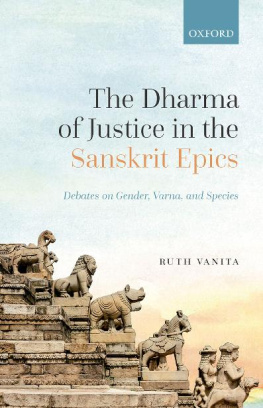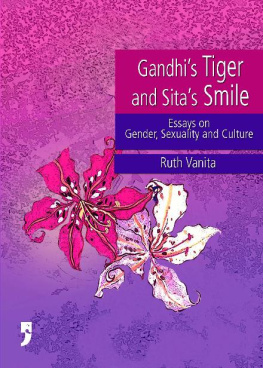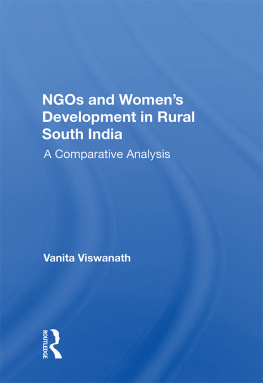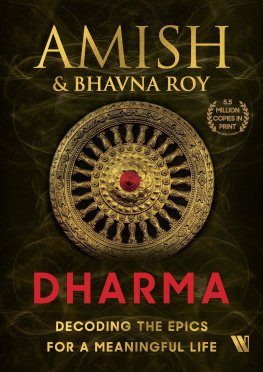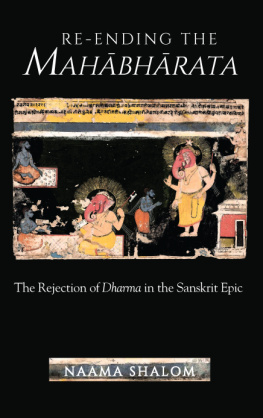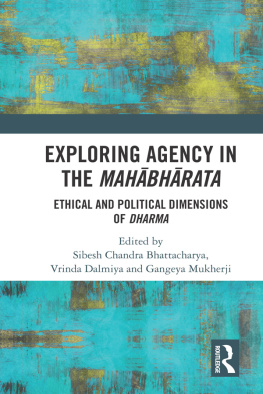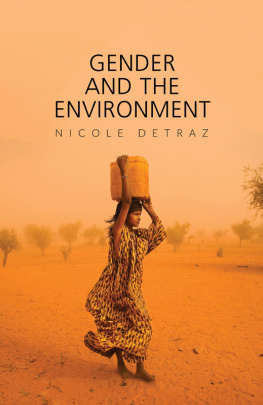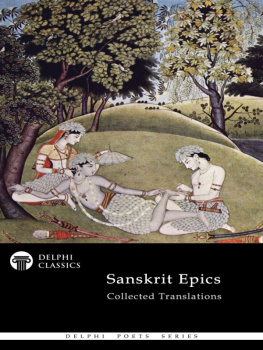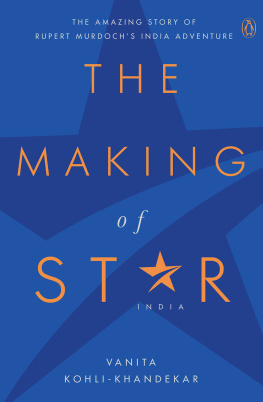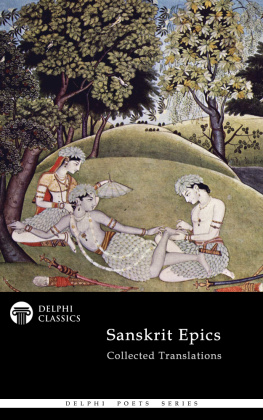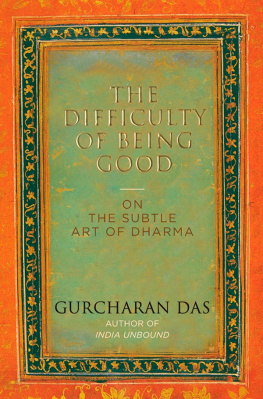The Dharma of Justice in the Sanskrit Epics
The Dharma of Justice in the Sanskrit Epics
Debates on Gender, Varna, and Species
RUTH VANITA
Oxford University Press is a department of the University of Oxford. It furthers the Universitys objective of excellence in research, scholarship, and education by publishing worldwide. Oxford is a registered trade mark of Oxford University Press in the UK and in certain other countries
Published in India by
Oxford University Press
22 Workspace, 2nd Floor, 1/22 Asaf Ali Road, New Delhi 110002, India
Ruth Vanita 2022
The moral rights of the author have been asserted
Impression: 1
All rights reserved. No part of this publication may be reproduced, stored in a retrieval system, or transmitted, in any form or by any means, without the prior permission in writing of Oxford University Press, or as expressly permitted by law, by licence or under terms agreed with the appropriate reprographics rights organization. Enquiries concerning reproduction outside the scope of the above should be sent to the Rights Department, Oxford University Press, at the address above
You must not circulate this work in any other form and you must impose this same condition on any acquirer
ISBN13 (print edition): 9780192859822
ISBN10 (print edition): 019285982X
ISBN13 (eBook): 9780192676016
ISBN10 (eBook): 0192676016
ISBN13 (OSO): 9780191953149
ISBN10(OSO): 0191953148
DOI: 10.1093/oso/9780192859822.001.0001
for Leela Gandhi,
and for my son Arjun
Lead me from what is not to what is
Brihadaranyaka Upanishad
Contents
Transliteration
I use standard conventions with the following exceptions:
ch instead of c in words like chru
chh instead of ch in words like chhat
sh instead of
I spell skhya thus instead of skhya . I do not use diacritics for the names of persons, places, and well-known texts like the Vedas or the Gita, or italics for common words, such as dharma and yoga.
When quoting from a source written in English, I retain the spelling used in the source.
Texts and Abbreviations
| The Mahbhrata: For the First Time Critically Edited (Sukthankar) | Mbh |
Mahabharata Southern Recension | SR |
| Valmiki Ramayana, critical edition, Krishnacharya | VR |
Valmiki Ramayana Southern Recension | VRSR |
r Rmacaritamnasa | RCM |
Kabir Granthavali | KG |
For the last text and all the bhakti texts, the first number cited is the page number, and the number after the colon is the verse number.
Translations
Translations from the Mahabharata are by Ganguli or Debroy. Debroy translates from the critical edition. Gangulis translation is closer to the southern recension, and he also uses other manuscripts. Neither Debroy nor Ganguli uses verse numbers so I refer to Debroy by his own volume and page number, thus Mbh 12.254 is Debroy 9.156, and to Ganguli by his chapter numbering, thus Mbh 14.68 is Ganguli 14.69. For the Ramayana, unless otherwise indicated, I use Debroys translation, and for Bhagavad Gita , Schweigs.
All unattributed translations throughout are by me.
In general, I rely on the critical editions of the epics, but I also use the southern and other recensions. As , notes, there is no reason to hold that one version is more authentic than the other because its manuscript is shorter and earlier. That is why I do not give much heuristic value to the reconstituted text of the critical edition (86). Dunham, Manuscripts used in the Critical Edition of the Mahbhrata, points out that the critical edition, despite its virtues, is a reconstruction that is not genuinely historical at all (17). Also, the critical editions omission of some major episodes, such as Draupadis crying out to Krishna when she is stripped, and Urvashis curse of Arjuna, necessitates referring to other recensions.
This book considers how the Mahabharata and the Ramayana debate questions of justice. The epics depict discrimination based on social categories such as gender, vara , species, age, and disability, and important characters often practice discrimination and support prejudices based on these categories. But the epics also criticize oppression in two waysfirst, philosophically, through debates and important characters views, and second, practically, through characters whose actions demonstrate that discrimination is wrong.
By celebrating supposedly low-status characters (such as single women and shdra s) as upholders of dharma, who act in ways that laws prohibit, the epics show that dharma is more than laws, and that laws which contradict reality are incorrect. For example, the epics praise single women teachers who live independently without a father, husband, or sons protection; these women demonstrate that such protection is unrealistic. Exceptions to rules may be more firmly grounded in knowledge than rules themselves.
I argue that the epics equip characters within the text, as well as readers or listeners, with intellectual tools to dismantle conventional ideas of difference. Ordinary people continued such interpretations, with regard to later retellings of the epics.
For example, Hess recounts how she asked a devotee of Tulsis Ramcharitmanas what he thought of Sagara, the embodiment of the ocean, stating in this book that drums, rustics, shdra s, animals, and women deserve to be beaten. Thus, he was a devotee of the text without agreeing with every word in it.
The epics idea of dharma is based on an understanding of the nature of reality (what is termed ontology). This foundational understanding is crucial to discussions on how to act.
Philosophical Framework
Many characters in the epics (including men and women from all vara s and those who would later be placed outside the vara system) repeatedly proclaim the principle of sameness ( samatva ). This principle is based on a shared understanding of reality. All bodies are made of the same matter and all consciousnesses can be seen as many manifestations of one consciousness or else as many consciousnesses linked to one another.
The narrator of the Mahabharata, sage Vaishampayana, summarizes this understanding of reality (12.338339). He states that all the many individual consciousnesses spring from one supreme consciousness spoken about in the Vedas (12.338.5). This consciousness is satya (real, true) and ta (right). This consciousness is the invisible origin of all things (12.338.24) and is the universe (12.338.25).
This consciousness is the universe, sagua or with qualities, and nirgua or without qualities, seen and remembered through wisdom (12.339.2). Though bodiless, it resides in all bodies and is the witness of all actions but is untouched by them (12.339.34). The universe is its arms, the universe is its feet, the universe is its eyes and nose (12.339.5).
Its oneness and manyness are like the one ocean and the many water sources, or the one sun and the many sources of light (12.339.10). Some wise ones desire this consciousness as the paramtman (supreme self) while others consider it the tman in themselves (12.339.13). It is known as Narayana and is in all tman s (12.339.14); it is the knower and the known, the seer and the seen (12.339.17).

